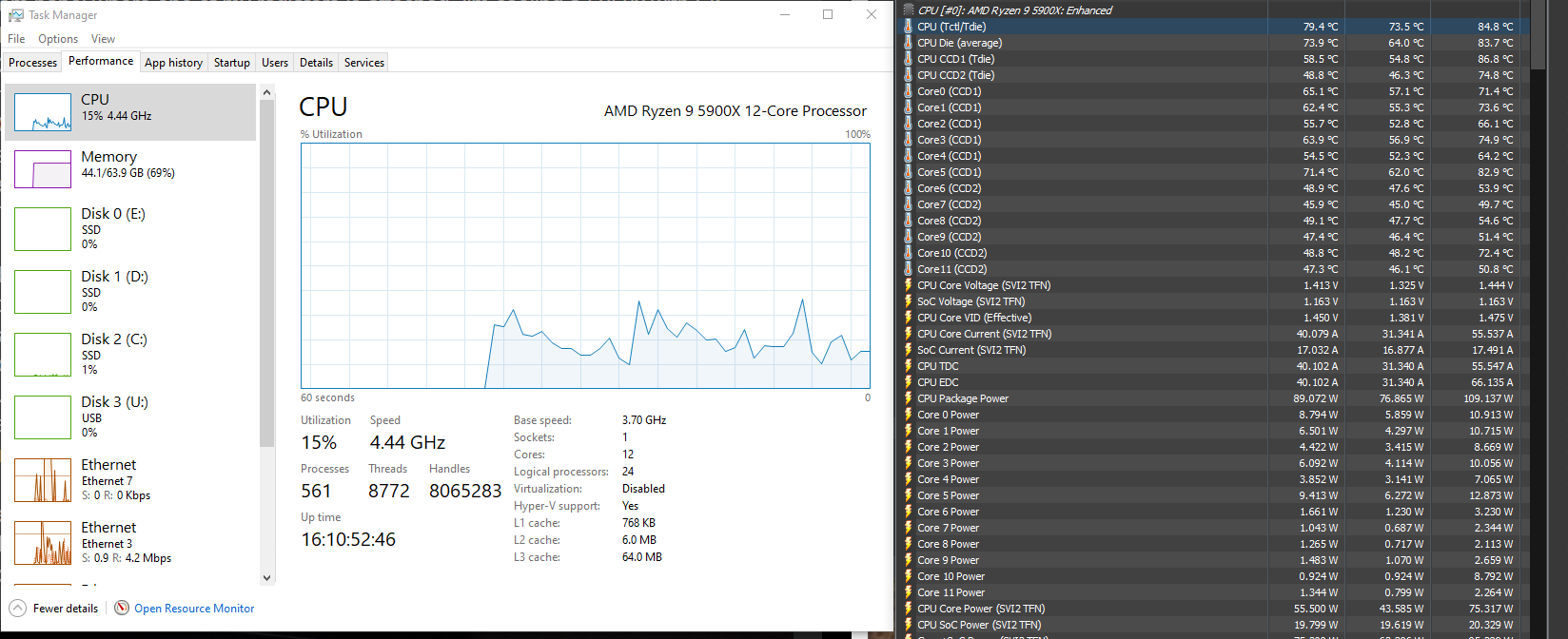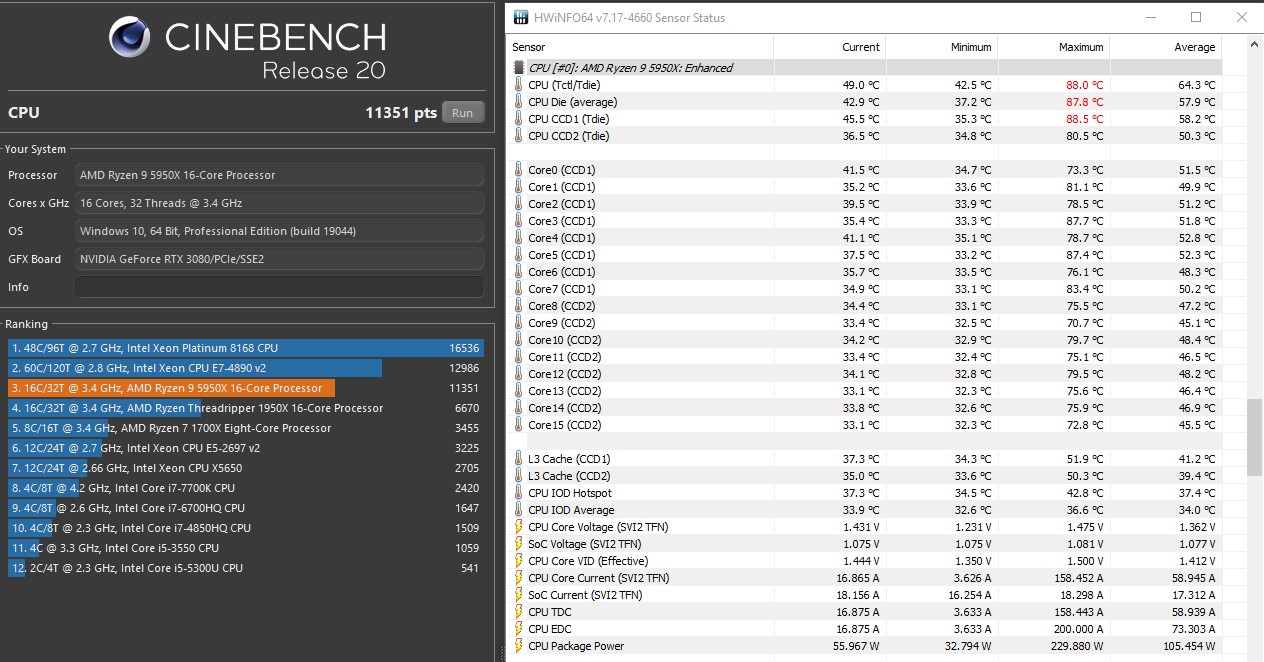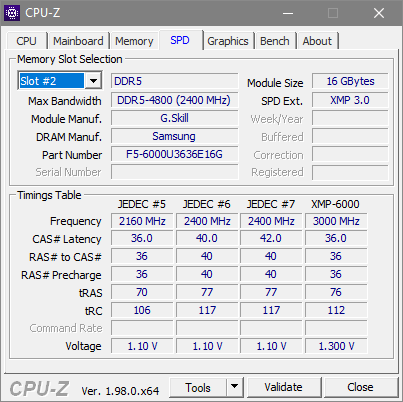kamikazi
[H]ard|Gawd
- Joined
- Jan 19, 2006
- Messages
- 1,611
The case is a Lian-Li PC011 Dynamic that I've modified by cutting the restrictive bottom floorplate out to better accommodate intake fans.. I've also replaced the front glass with a custom panel where one of my radiators is attached. I'm cooling a 5950x with EK Quantum block and a 3080 with EK Vector block. I have a Corsair XR7 360mm radiator (54mm thick) and a Corsair XR7 240mm radiator (54mm thick). The pump is an EK DDC 4.25 pump in the EK Lian-Li Distroplate. I have the pump set at a constant 4000 rpm and I have a curve on the fans. Everything is controlled with an Aquacomputer Aquaero 6. I have two inline water temp sensors, one in the distro-plate and one between the GPU and CPU. I also have some ambient temperature probes attached to the aquaero. Each radiator has Corsair LL120s on it in push configuration. I also have 2 LL120s as intakes on the bottom of the case. Coolant flow goes Reservoir->240 rad->360 rad->GPU->CPU->Reservoir. I'm running PBO on the CPU. I didn't mess with voltage other than to lower it on one of the CCDs by 15 mv. The 3080 EVGA FTW Ultra is at complete stock.
Anyway, my CPU will now spike up to 90C (Tctl/Tdie in HWINFO) with regularity when opening programs, etc. even when the GPU is running idle at 27 or 28C and ambient temp is 23 or 24C. When I was only cooling the CPU with a 360, it would never get close to that. I know it's just a spike and if I run 3D Mark, I actually get a better CPU score now than I did with the single 360. Is this problem solely the difference in my CPU being last in the loop? Is the CPU stretching it's legs with better cooling? In Microsoft Flight Simulator 2000 (Geforce Experience settings at 1440p), CPU gets as hot as the 80s at times, but normally runs in the 60s I think. The GPU tends to get to about 56C on the core (HWINFO reading) and stays there. I'm cooling based on liquid temperatures. With ambient temperature of usually 23 to 24C, the average liquid temperature gets up to around 37.5C. At that point, I'm kind of at equilibrium with all of my fans are running around 1700-1800 rpm, so not exactly quiet (max fan speed is 2150 or so and max pump speed is around 4500 for reference). That gives me an Air-Water delta of 13 to 14C. That seems high to me given the research I've done on other systems. Also, I see people with a 3080ti overclocked with my waterblock saying that they stay in the 40s on the core. Any ideas as to what I should look at first? Am I actually good to go? Pic of the system below.

Anyway, my CPU will now spike up to 90C (Tctl/Tdie in HWINFO) with regularity when opening programs, etc. even when the GPU is running idle at 27 or 28C and ambient temp is 23 or 24C. When I was only cooling the CPU with a 360, it would never get close to that. I know it's just a spike and if I run 3D Mark, I actually get a better CPU score now than I did with the single 360. Is this problem solely the difference in my CPU being last in the loop? Is the CPU stretching it's legs with better cooling? In Microsoft Flight Simulator 2000 (Geforce Experience settings at 1440p), CPU gets as hot as the 80s at times, but normally runs in the 60s I think. The GPU tends to get to about 56C on the core (HWINFO reading) and stays there. I'm cooling based on liquid temperatures. With ambient temperature of usually 23 to 24C, the average liquid temperature gets up to around 37.5C. At that point, I'm kind of at equilibrium with all of my fans are running around 1700-1800 rpm, so not exactly quiet (max fan speed is 2150 or so and max pump speed is around 4500 for reference). That gives me an Air-Water delta of 13 to 14C. That seems high to me given the research I've done on other systems. Also, I see people with a 3080ti overclocked with my waterblock saying that they stay in the 40s on the core. Any ideas as to what I should look at first? Am I actually good to go? Pic of the system below.

![[H]ard|Forum](/styles/hardforum/xenforo/logo_dark.png)



